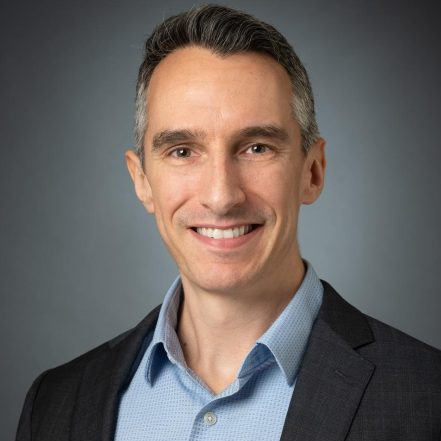Advancing Canada’s AI-driven medical imaging industry: Q&A with Phil Boyer of INOVAIT
Authors
 Yolande Dufresne
Yolande Dufresne
Phil Boyer
Canadian innovators have long worked within the intersection of artificial intelligence and medical imaging, gaining a reputation as industry leaders. However, gaps between research and adoption remain. Yolande Dufresne, Counsel, joins Phil Boyer, Health Data Innovation Program Manager at INOVAIT, to discuss the data-sharing barriers that health organizations and developers face and how the principles within INOVAIT’s Data Mobilization framework can offer both parties guidance on how to move health data licensing in Canada forward.
How does Canada compare to others in the field of AI-driven medical imaging technologies?
Phil: Our globally renowned academic institutions and clinical centres have cemented our standing as a world leader in AI research, with our research hospitals consistently recognized as being among the best in the world. We have a well-educated and diverse population and a highly skilled talent base. Additionally, non-dilutive funding for medical research is widely available and government support is strong—as evidenced by numerous research and innovation programs, including INOVAIT, whose host institution, Sunnybrook Research Institute, is a globally recognized leader in image-guided therapy.
We have a tremendous opportunity to leverage our AI and medical imaging expertise to form a globally competitive industry. However, Canada is not fully capitalizing on these strengths to translate AI imaging research into Canadian-made products that are adopted and deployed into clinical care. There are many reasons for this, with access to high-quality health data being one of them. Solving the data access issue would encourage the growth of the Canadian AI medtech sector, so cutting-edge homegrown technology can benefit patients at home and abroad.
What are the current legal barriers to leveraging data for AI-driven medical imaging technologies? How can they be addressed?
Yolande: Safeguarding patient privacy is incredibly important, so respecting the legal protection of personal information is one of the main barriers to using data for AI-driven medical imaging technologies. These technologies typically need to train on large, representative patient datasets, which poses questions on whether this data can be sufficiently anonymized for further analysis in compliance with Canadian privacy laws. Novel approaches to overcoming these challenges include leveraging new anonymization and encryption tools, and developing synthetic datasets designed to mimic the statistical properties and structure of real-world data.
Another major question relates to intellectual property rights in datasets—ownership of which can be particularly complex. AI developers may be infringing third-party copyrights if they have not appropriately in-licensed data sets or if they are using datasets that they have not independently developed. Iterative modifications to datasets over time can also make intellectual property ownership questions difficult to navigate.
Further, many AI-driven imaging technologies are regulated as medical devices in Canada and are subject to heightened pre-market requirements, which includes good machine learning practices. In terms of data requirements, this means that training sets should be representative of the technology’s intended user base and should typically be distinct from the datasets used to validate and test the efficacy of the end-product. This increases the burden on medtech developers to access large, high-quality, well-organized datasets to satisfy the safety and efficacy requirements for regulated medical devices.
What are the operational and logistical barriers to accessing health data for AI-driven imaging technologies from Canadian healthcare institutions?
Phil: Generating a high-quality dataset and providing access can be challenging for several reasons. Data may not have been collected, created, or stored with secondary use in mind. It could be of inconsistent quality or be housed in institutional silos. The teams tasked with assembling the dataset may have other clinical duties that take priority, resulting in gaps and delays. In some instances, pulling the data might interfere with the use of clinical systems for patient care.
When combining datasets from multiple institutions for more robust algorithms, there can be challenges in finding a common structure or data standards as well as differing ethics approvals around consent for use. The limited capacity within varying institutional teams often hampers the timely resolution of data transfer agreements. Delays in data provision can not only translate into longer development timelines but also increased costs since companies must continue to operate and pay staff salaries.
To combat some of these issues, institutions need processes to assess data sharing requests with private sector partners. This may require specialized committees, expertise, or tools. Without these, it may be unclear how to address data access requests—leading to frustration, confusion and delay.
How does Canada’s current health data licensing environment differ from other key jurisdictions?
Yolande: The nature of a country’s healthcare system can impact its overall health data licensing environment. In countries with predominantly private healthcare systems, such as the US, an individual’s health data is often linked to their private health insurer, which is frequently a function of their current employer’s benefit plan. If a person begins a new employment position and changes private insurance providers, this can lead to disjointed patient care datasets as each provider may hold separate information on them.
In countries with public health insurance systems, such as Canada, an individual’s patient care datasets might be organized by a hospital network or on a more granular level in local electronic medical records. Where public health insurance systems exist, government bodies (such as public hospitals) might prioritize factors like transparency, acceptable risk, and data monetization differently than private companies, such as private insurers. These differences in data storage and maintenance can also affect the overall data licensing environment.
How does INOVAIT’s Data Mobilization framework address data access barriers?
Phil: Healthcare institutions are, of course, aware that the data they store could be used to develop technologies that can improve patient outcomes and generate valuable revenue streams to support research and operations. Industry plays a central role in both advancing research and turning it into products for clinical care. Unfortunately, industry is often regarded with suspicion or distrust, and in such scenarios, not sharing data can become a default.
There can also be challenges around responsibly providing access to de-identified information and, as a result, there are patchwork approaches to data governance and often little guidance.
When applied, INOVAIT’s Data Mobilization framework can foster and maintain public trust. Key principles within the framework include transparency, multi-disciplinary oversight with public and patient involvement, Indigenous data sovereignty, and limiting licensing to only opportunities that benefit the public good. Together they form a foundation for trustworthy behaviour in alignment with current legislation. At INOVAIT, we believe this is the missing piece—and critical enabler—for healthcare institutions to responsibly engage in data sharing for technological development.
How does the current legal/regulatory approach to medical technology in Canada align with INOVAIT’s eight principles?
Yolande: Transparency, anonymization, responsibility and oversight are pillars of Canada’s current privacy laws. In particular, the Canadian government has long recognized the need to strike a balance between an individual’s right to privacy of personal information and the need for organizations to collect, use or disclose personal information for legitimate purposes1. Many would argue that there is a legitimate need to leverage health data to advance medtech and to avoid a plateau in health innovation; however, determining how to balance different stakeholder interests can be even more challenging when sensitive personal information is involved, even when it is de-identified. INOVAIT’s Data Mobilization framework highlights many factors that industry and public bodies should be weighing when involved in data licensing decisions.
Why is data licensing so integral to advancing health care and medical technologies in Canada?
Phil: Canadian medtech companies primarily rely on data licensing for AI algorithm development. If companies cannot source domestic data, they license it from elsewhere. Training Canadian AI on foreign data that does not reflect the diversity or health needs of Canadians creates greater potential for biases and unsatisfactory outputs. This can also have negative downstream impacts, such as lost collaboration opportunities between Canadian academic institutions and industry, resulting in less funds flowing into the country. Canadian industry may be disadvantaged compared to its peers, have less incentive to engage with Canadian institutions, and therefore miss out on relationships that would encourage their technologies to be procured and deployed in Canadian healthcare settings.
What steps can Canadian healthcare institutions take to ensure responsible data sharing with private industry?
Phil: I would highly encourage institutions to consider implementing INOVAIT’s data licensing principles. Steps required for adoption are described in the framework. Many institutions already have most of the governance mechanisms in place, especially among larger hospitals and networks. In those cases, it requires committing to a standard of behaviour and developing public-facing material to fulfill transparency requirements.
What would be your top recommendations for medtech companies as they look to both develop AI in Canada and work with Canadian health institutions?
Yolande: To instill confidence, AI-driven medtech developers should readily demonstrate that they maintain highly robust data governance practices that reflect the sensitivity of the datasets leveraged for their products and services. This is a quickly evolving area, so staying informed of regulatory changes, seeking out advanced security practices and procedures and having a data governance checklist really are critical to success in this field.
For more information on our leading intellectual property and medical technology counsel, please visit our Intellectual Property page.
Phil Boyer is the lead author of “Data Mobilization: Principles for safely and ethically harnessing Canadian health data to unlock innovation, economic growth, and better patient care”. As a long-time supporter of health innovation in Canada through roles in commercialization and healthcare research, he currently leads the Health Data Innovation program at INOVAIT, Canada’s image-guided therapy and artificial intelligence (AI) network. Phil holds a PhD in Biomedical Engineering focused on AI in healthcare from the University of Toronto and Sunnybrook Research Institute.
INOVAIT is the national image-guided therapy (IGT) and artificial intelligence (AI) network developing and commercializing advanced groundbreaking AI-enhanced IGT technologies. To learn more, please visit the INOVAIT website.
To discuss these issues, please contact the author(s).
This publication is a general discussion of certain legal and related developments and should not be relied upon as legal advice. If you require legal advice, we would be pleased to discuss the issues in this publication with you, in the context of your particular circumstances.
For permission to republish this or any other publication, contact Janelle Weed.
© 2026 by Torys LLP.
All rights reserved.